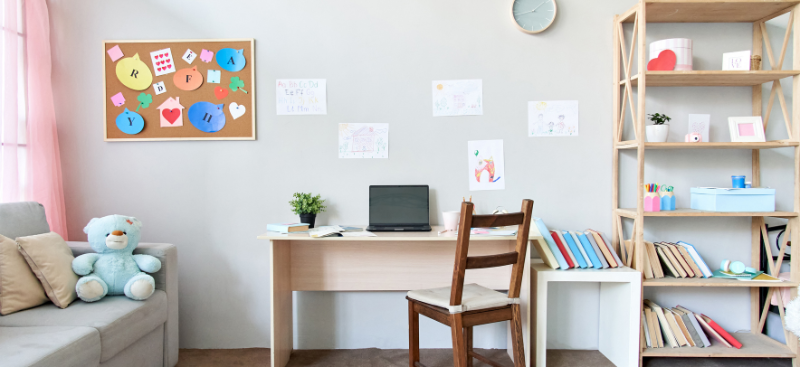Designating a Quiet Oasis of Learning
Imagine a quiet, well-lit study space where your child can immerse themselves in the world of knowledge. It’s free from distracting noises or clutter that might interrupt their focus. This sacred space isn’t just a study nook; it’s where habits of discipline and curiosity are nurtured. Creating the ideal study environment for your child is a priceless gift that can significantly impact their learning journey.

Here are some practical tips for parents to design the perfect study spot:
- Choose the Right Location: Find a suitable spot in your home that’s free from constant traffic or distractions. It could be a corner in their room, a quiet area in the living room, or even a cozy space in the backyard, weather permitting.
- Lighting Matters: Ensure there’s plenty of natural light during the day. Position the desk near a window if possible. For evenings or cloudy days, provide good artificial lighting with a desk lamp. Well-lit spaces enhance focus and reduce eye strain.
- Comfort is Key: Invest in a comfortable chair and desk, appropriately sized for your child. They should be able to sit with their feet flat on the floor and have good back support. A comfortable workspace encourages longer, more productive study sessions.
- Organizational Essentials: Equip the study area with all necessary supplies within arm’s reach. This includes pens, pencils, notepads, textbooks, and any other learning materials. Having everything at hand prevents the need to leave the workspace and disrupt focus.
- Minimize Distractions: Remove any potential distractions. Keep smartphones, tablets, and video games out of reach during study time. Ensure that the study area is free from unrelated clutter, as a tidy space can promote a calm and focused mindset.
- Personalize the Space: Encourage your child to personalize their study area with motivational quotes, artwork, or their achievements. This can create a sense of ownership and motivation, making them feel more connected to their learning space.
- Establish a Routine: Set a schedule for study time. This not only helps with time management but also signals to your child that it’s time to concentrate. Consistency in routine can train the brain to shift into “study mode.”
- Incorporate Storage Solutions: Organize the space with shelves, drawers, or storage containers for books, supplies, and completed assignments. A well-organized workspace reduces clutter and frustration.
- Stay Tech-Savvy: Depending on your child’s age and the requirements of their studies, a computer might be necessary. Ensure that it’s a dedicated study machine without access to social media or games during study hours. Some educational apps or websites can be beneficial, but they should be used in moderation and with parental guidance.
- Encourage Healthy Breaks: While creating a dedicated study area is crucial, remind your child to take regular breaks. Encourage them to step away from their desk, stretch, and refresh. This prevents burnout and maintains their enthusiasm for learning.
A well-designed study space can be the catalyst for nurturing your child’s discipline, curiosity, and academic success. By implementing these practical tips, you’re giving them a head start on their journey to becoming independent and enthusiastic learners.

Minimizing Digital Distractions
In today’s world, digital distractions can sabotage even the best study intentions. Encourage your child to put away electronic devices during study time, reducing the temptation to check social media or dive into games. This simple step can work wonders for concentration. In a world filled with digital diversions, helping children concentrate during study time can be quite a challenge. Here are more practical tips for parents to guide their children towards better focus:
- Set Clear Boundaries: Establish a rule that during study hours, electronic devices such as smartphones, tablets, and gaming consoles must be turned off and put away. Ensure that both you and your child understand and respect these boundaries.
- Designate Device-Free Zones: Create specific areas within your home where electronic devices are not allowed. The study area should certainly be one of these zones, but also consider designating the dining room, or even the bedroom if necessary, as tech-free spaces.
- Use Apps for Focus: Ironically, you can use technology to help limit technology use. There are apps and software designed to block distracting websites and apps during specific hours. Install and configure these with your child to prevent access to social media, games, and other distractions during study sessions.
- Lead by Example: Children often model their behavior after their parents. If they see you refraining from checking your phone or computer during designated study or work times, they are more likely to follow suit.
- Implement the Pomodoro Technique: This time management method involves breaking work into intervals, traditionally 25 minutes in length, separated by short breaks. During the work intervals, your child focuses solely on their studies. The breaks can be used for a quick tech check or relaxation. This technique can boost productivity and encourage brief, intentional device use.
- Use Parental Controls: Most electronic devices and Wi-Fi routers offer parental control features. You can set time limits and content restrictions to limit digital distractions. These controls can automatically turn off the internet or certain apps during study hours.
- Schedule Tech Breaks: It’s essential to recognize that technology can be a valuable learning tool. Schedule short tech breaks between study sessions, allowing your child to use their devices for educational purposes or leisure. These structured breaks can be motivating rewards for focused study.
- Educate on the Consequences: Explain to your child the impact of digital distractions on their academic performance. They need to understand that for every minute spent on social media or games during study time, they’re losing valuable learning time. Understanding the consequences can encourage self-regulation.
- Encourage Offline Activities: Promote activities that don’t involve screens, such as reading physical books, drawing, or engaging in hobbies. Encourage your child to explore the joys of non-digital entertainment. This can help them appreciate the benefits of reduced screen time.
- Stay Involved and Supportive: Be present and interested in your child’s learning journey. Regularly discuss their study goals and progress. Offer to help with challenging subjects or assignments. Your support can be a motivating factor for staying on task.
- Celebrate Successes: Acknowledge your child’s ability to focus and study without digital distractions. Celebrate small victories with praise or rewards. Positive reinforcement can make the effort feel worthwhile.
By implementing these strategies, parents can guide their children toward better concentration and effective study habits, ultimately setting them up for academic success in a digitally distracted world.
Equipping for Success
A well-organized study area is incomplete without the essential tools at arm’s reach. Textbooks, notebooks, pens – make sure your child doesn’t waste precious study minutes searching for these basics. And don’t forget a reliable internet connection for smooth online research. Ensuring that your child’s study area is well-equipped with the necessary tools and resources is a fundamental aspect of preparing them for success. Here are some practical examples of what parents can do to equip their children for effective studying:
- Organize School Supplies: Help your child organize their study materials in an easily accessible manner. Consider providing a set of labeled containers or drawers for different supplies, such as one for pens and pencils, another for notebooks, and a separate one for art supplies if they are also pursuing creative subjects.
- Create a Study Supplies Checklist: Develop a checklist that your child can use to ensure they have everything they need before starting a study session. This list should include items like textbooks, notebooks, writing utensils, and any specific materials required for their current assignments or projects.
- Stock Up on Stationery: Ensure a steady supply of stationery, including pens, pencils, highlighters, erasers, and any other tools your child might need. When items are running low, it can be a source of distraction to search for replacements.
- Designate Shelves or Storage: Designate specific shelves or storage space for textbooks, reference materials, and notebooks. This not only helps keep their study area organized but also prevents these items from getting misplaced or lost.
- Invest in a Study Desk or Organizer: Consider purchasing a study desk with built-in storage or an organizer that includes compartments for school supplies. This keeps everything neatly arranged and within arm’s reach during study sessions.
- Digital Device Management: If your child requires digital devices for their studies, ensure they are well-maintained, charged, and ready for use. Encourage your child to charge their devices overnight, so they start their study sessions with a full battery.
- Digital Backup Solutions: Introduce your child to the importance of backing up digital work. Teach them how to save their work to cloud storage or external hard drives. This ensures that important documents are never lost due to technical issues.
- Establish a Routine for Resource Check: Encourage your child to routinely check and restock their study area. This could be a weekly task, ensuring that supplies are always in good order.
- Foster Responsibility: While parents can help set up and organize the study area, it’s crucial to teach your child to take responsibility for maintaining it. This includes putting supplies back in their designated spots after each study session.
- Internet Reliability: In today’s digital age, a stable and reliable internet connection is crucial for online research. Ensure your home’s Wi-Fi network is reliable and capable of handling research needs without interruption. Set up parental controls to prevent access to non-educational websites during study hours.
- Personalized Study Resources: Identify the subjects or topics your child finds most challenging and provide additional resources. For example, if they struggle with math, consider investing in a math workbook or hiring a tutor. Tailoring resources to their individual needs can significantly enhance their learning experience.
By implementing these practical steps, parents can contribute to creating an environment that is conducive to focused and productive studying, ultimately equipping their children with the tools they need for academic success.
If you are also interested in tips for adults, you may want to visit this blog post on The Art Of Language Learning In Your 20s And Beyond.




